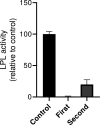Severe acquired hypertriglyceridemia following COVID-19
- PMID: 34764129
- PMCID: PMC8587683
- DOI: 10.1136/bcr-2021-246698
Severe acquired hypertriglyceridemia following COVID-19
Abstract
Severe hypertriglyceridemia is a major risk factor for acute pancreatitis. In exceptional cases, it is caused by plasma components inhibiting lipoprotein lipase activity. This phenomenon is predominantly associated with autoimmune diseases. Here, we report a case of severe hypertriglyceridemia due to a transient reduction in lipoprotein lipase activity following an episode of COVID-19 in an otherwise healthy 45-year-old woman. The lipoprotein lipase activity of the patient was markedly reduced compared with a healthy control and did recover to 20% of the healthy control's lipoprotein lipase activity 5 months after the COVID-19 episode. Mixing tests substantiated reduced lipolytic capacity in the presence of the patient's plasma at presentation compared with a homozygous lipoprotein lipase-deficient control, which was no longer present at follow-up. Western blotting confirmed that the quantity of lipoprotein lipase was not aberrant. Fibrate treatment and a strict hypolipidemic diet improved the patient's symptoms and triglyceride levels.
Keywords: COVID-19; lipid disorders; pancreatitis.
© BMJ Publishing Group Limited 2021. Re-use permitted under CC BY-NC. No commercial re-use. See rights and permissions. Published by BMJ.
Conflict of interest statement
Competing interests: None declared.
Figures



References
Publication types
MeSH terms
Substances
LinkOut - more resources
Full Text Sources
Medical
